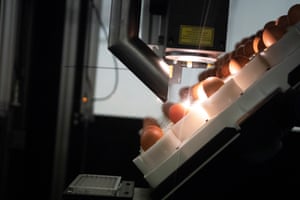https://www.theguardian.com/environment/2018/dec/22/worlds-first-no-kill-eggs-go-on-sale-in-berlin
World's first no-kill eggs go on sale in Berlin
Chick’s sex can be determined before it hatches, potentially ending culling of billions of males
The world’s first ever no-kill eggs are now on sale in Berlin after German scientists found an easy way to determine a chick’s sex before it hatches, in a breakthrough that could put an end to the annual live shredding of billions of male chicks worldwide.
The patented “Seleggt” process can determine the sex of a chick just nine days after an egg has been fertilised. Male eggs are processed into animal feed, leaving only female chicks to hatch at the end of a 21-day incubation period.
“If you can determine the sex of a hatching egg you can entirely dispense with the culling of live male chicks,” said Seleggt managing director Dr Ludger Breloh, who spearheaded the four-year programme by German supermarket Rewe Group to make its own-brand eggs more sustainable.
The patented “Seleggt” process can determine the sex of a chick just nine days after an egg has been fertilised. Male eggs are processed into animal feed, leaving only female chicks to hatch at the end of a 21-day incubation period.
“If you can determine the sex of a hatching egg you can entirely dispense with the culling of live male chicks,” said Seleggt managing director Dr Ludger Breloh, who spearheaded the four-year programme by German supermarket Rewe Group to make its own-brand eggs more sustainable.
“It’s not about winning or losing,” he added of the worldwide race to find a marketable solution. “We all have the same goal, which is to end the culling of chicks in the supply chain. Of course, there’s competition, but it’s positive in that it keeps us all focused on that goal.”
An estimated 4-6 billion male chicks are slaughtered globally every year because they serve no economic purpose. Some are suffocated, others are fed alive into grinding or shredding machines to be processed into reptile food.
The culling is a messy solution to a thorny problem of modern poultry farming. Humans have bred chickens for one of two purposes: to produce eggs, or meat. Yet half of all the animals bred for this purpose are considered useless. Male chicks lay no eggs and don’t grow fast enough to justify the cost of feeding them up for meat. So, they are simply destroyed.
The culling is a messy solution to a thorny problem of modern poultry farming. Humans have bred chickens for one of two purposes: to produce eggs, or meat. Yet half of all the animals bred for this purpose are considered useless. Male chicks lay no eggs and don’t grow fast enough to justify the cost of feeding them up for meat. So, they are simply destroyed.
Chick culling has become increasingly controversial. In 2015, a video went viral of an Israeli animal rights activist shutting down a chick shredding machine and challenging a police officer to turn it back on. Consumer kickback has prompted a global race to develop a more humane solution.
Breloh said his first breakthrough came when he approached scientists at the University of Leipzig where Prof Almuth Einspanier had developed a chemical marker – similar to a pregnancy test – that could detect a hormone present in high quantities in female eggs. Mixed with fluid from fertilised eggs at nine days, the marker changes blue for a male and white for a female, with a 98.5% accuracy rate.
Next Breloh had to find a way of making the test easy for everyday use in hatcheries. He approached Dutch technology company HatchTech and asked them to make an automated machine to conduct Einspanier’s test from beginning to end.
It had to be easy to use, scalable, flexible, precise, hygienic and above all, fast – the eggs couldn’t be out of the incubator for more than two hours. The biggest problem was how to extract test fluid quickly from the egg without damaging it. A needle would work, but it was invasive and also brought additional hygienic problems.
Instead, a laser beam burns a 0.3mm-wide hole in the shell. Then, air pressure is applied to the shell exterior, pushing a drop of fluid out of the hole. The process takes one second per egg and enables fluid to be collected from eggs without touching them.
“It worked absolutely faultlessly,” said Breloh of the test phase. “Today, female hens are laying eggs in farms in Germany that have been bred without killing any male chicks.”
Earlier this year Seleggt hatched the first brood of hens bred using the method. Their eggs – the first to be sold from hens reared without killing male chicks - hit supermarket shelves in Berlin in November, bearing the seal “respeggt”.
Rewe Group plan to roll out the eggs across German stores next year, while Seleggt plans to install the technology in independent hatcheries from 2020. Seleggt will require supermarkets to pay a few extra cents on every box of eggs sold with their “respeggt” seal. Eventually, the group hopes to expand the model across Europe.
“With the market readiness of [this] process, Germany is a pioneer,” said German minister of food and agriculture, Julia Klöckner, whose ministry funded the project. “Once the process is made available to all and the hatcheries have implemented [it], there will be no reason and no justification for chick culling.”
• This article was amended on 26 December 2018. An earlier version referred to a chick’s “gender” rather than its sex in the main text and subheading.



沒有留言:
張貼留言